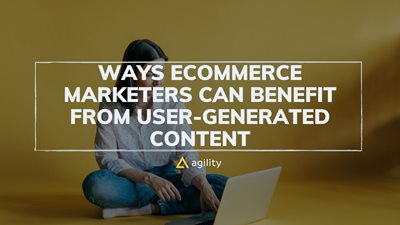Ways eCommerce Marketers Can Benefit from User-Generated Content
What USG is best for Ecommerce?


User-generated content, aka UGC, is a self-explanatory concept at first glance because it refers to all content created by users. Things get complicated when you start thinking about who precisely those users are and what sort of content they’re making.
Those users could be:
- Customers
- Potential customers
- Employees
- People who haven’t heard of your brand/products but know of a campaign hashtag
- People who prefer the competition
- People who hate your brand

The first three categories of users produce the best content, while the last will make the worst content regarding your brand. That’s why UGC marketing is so tricky:
- You have to encourage only desirable content.
- That content has to be a cog in the larger machinery of your UGC strategy.
- Specific tools in that strategy (e.g., hashtags, influencers, wacky campaigns) mustn’t eclipse your brand.

Basically, you won’t have to worry about producing content, but you’ll still have to make sure that content works to your advantage. This article will tell you how to do that as we tackle statistics, examples, and practical advice.
Keep reading below.
5 Reasons E-commerce Companies Benefit from UGC
Just look at some UGC stats:
- UGC ads have 400% higher click-through rates, and they cost half as much as traditional ads.
- 90% of people will make a purchase decision based on UGC.
- 73% of people have more confidence in their purchases if a particular brand employs user-generated content.
- 61% of shoppers find themselves encouraged to engage more with certain brands thanks to the user-generated content surrounding them.
With that in mind, here’s how your e-commerce business can specifically benefit from User-Generated Content:
1. Your Customers Have Less Shopping Anxiety
Shopping anxiety is specifically high if you’re running an e-commerce website because people can’t try your products. This problem is substantially reduced for preexisting customers who know the quality of products and service they can expect from you.

Imagine this.
You’re a 35-year-old woman with heavy menstrual flow. You were raised in a strict environment, so you don’t feel comfortable trying new sanitary options apart from the pads you’ve gotten used to.
But one day, you see an ad to an e-commerce platform selling menstrual underwear.
That is based on customer reviews and other user-generated content, so it hooks you immediately. You still have questions, but you’re more tempted to try this innovative product because you trust the experience of similar women.
2. You add more Credibility to Your Content
When your loved ones recommend a specific product, you’re more likely to try that product instead of another for which you simply see traditional ads. Of course, we’re talking about the case where you don’t have any specific preferences.
That’s how UGC works.
Customers can see how other people use your products and how your brand improves those people’s lives. That strategy short-circuits abstract reasoning.
Don’t get us wrong; critical thinking is a massive advantage for humans. However, people can quickly come up with abstract arguments against your brand:
- They don’t have the money.
- They don’t know if it will work.
- They don't really need it.
- They’re using another product.
By comparison, UGC doesn’t allow these arguments because it shows your products’ concrete–and perhaps innovative uses.
Pro tip: Focus on content curation. You want to pick relevant and high-quality content to add value to your business.
Learn more from Cineplex Case Study.
3. You Become More Relevant (and Spend Less Money in the Process)
User-generated content for eCommerce marketing works because regardless of what you’re selling and how much you’ve invested in research, your customers will always find new uses for your products that you’re not even dreaming of.
That’s why UGC is so influential; the slightest twist or catch found by a loyal customer could attract more shoppers.
For example, Bluehouse Salmon relies exclusively on UGC marketing, mainly because traditional advertising ideas for a brand selling organic salmon are limited. There are only so many ways to tout the benefits of eating healthily.
But Bluehouse Salmon thrives from UGC based on recipes, encouraging its customers to post those recipes on Instagram. As a result:
- Existing customers feel like they matter in the grand scheme of things.
- Potential customers get inspired and motivated to try this brand.
- Bluehouse Salmon doesn’t have to worry about producing new content because it exclusively powers up its content calendar with UGC.
4. You Build a Community
New customers seek UGC because it’s credible and authentic. Conversely, existing customers post UGC because it makes them feel special as they:
- Find new uses for your product.
- Show others their creativity or favorite activities.
- Compare themselves with other people.
All those needs make people gravitate towards a community where they can share interests, passions, and problems. Of course, that community should be built under your brand’s umbrella.
Pro tip: Encourage unique UGC that binds people but offers strict guidelines for quality content.
5. You Increase Organic Reach and Conversion Rates
This world we live in has millions of similar products and brands, so it’s challenging to stand apart from your competition. Besides, social media algorithms don’t favor branded content.
Your e-commerce company can still thrive with UGC. For example:
- You could ask your customers to share your products and their experiences using your products on their social media. You can motivate people to do that by offering specific rewards, such as discounts or the chance to be featured on your website.
- Repost that UGC. That strategy gets you more followers that form a community around your brand.

This strategy helps you bypass stringent social media algorithms and, as a result, boost your conversion rates. The trick is to:
- Encourage your customers to produce desirable UGC.
- Curate that content they’ve created.
- Disseminate only the best UGC.
Does that sound complicated? Well, there’s good news. Here’s:
7 Ways to Leverage UGC for Your eCommerce Business
Now that you’re here, you know how your e-commerce business can benefit from user-generated content. Still, it’s one thing to understand those benefits from a theoretical perspective and something completely different to see them in practice.

Thus, without further ado, let’s look at seven excellent ways to leverage UGC:
1. Power Up Your E-mail Marketing Campaign
Many marketers consider e-mail marketing obsolete, even though, according to Forbes, this tool is still very effective. The trick is to do it correctly.
That means focusing on your customers’ needs.
- What motivates them?
- What do they want to see?
- How can your products help them?
For example, when you launch a new product, you have to reduce that shopping anxiety. UGC helps you do that by featuring product reviews and testimonials from industry influencers in your e-mail marketing campaign. Similarly, you can have an affiliate marketing agreement so affiliates and influencers post your link in their newsletters.
Or, let’s say you want to focus on abandoned cart e-mails because a consistent part of your potential customers doesn’t finish their online purchases.
In this case, you have to do more than simply underline your products’ features.
Leverage those e-mails as an opportunity to show actual customers using your products in specific contexts. This strategy creates lust and social proof so that people who’ve abandoned their carts are more likely to finish their purchases.

2. Use Customers as Spokespeople
If you’re doing your job right, your product pages are already top-notch because low-quality photos don’t sell. The problem is there will always be a better website than yours.
Here’s what you can do:
Turn your loyal customers into models, opinion leaders, and brand voices. This strategy will set you apart from the competition because people are sick of seeing glowing ads that lack substance.
That brings us to another essential point:
You can use UGC to underline your brand’s values. Do this correctly, and people will buy your products because they want to stand with your brand, not just because what you’re selling is useful.
And that’s how you start a community based on shared ideals.
Take Under Armour’s #UnlikeAny campaign. This campaign aims to change the mindset that only fit people can wear athletic clothing. Thus, Under Armour underlines its stance regarding an essential subject around body image, body positivity, and inclusion.

3. Highlight Unique Benefits
If you’re not selling tangible products, you have to be more creative with your advertising strategy. That’s highly taxing in the long run, primarily if you’re relying heavily on branded content and traditional ads.
UGC can change the game for you.
Take Buffer, for instance. As more people start working remotely by the day, they search for systems and solutions that facilitate this work as well as help them ease their minds while working.
The #BufferSpaces campaign gives people worldwide the chance to feature their exotic workspaces. Of course, their work is facilitated by Buffer, so the brand gains notoriety, prestige, and credibility points.
4. Develop a Relevant Q&A section
Allow your shoppers and potential customers to talk because increased interactions lead to more engagement and sales. Besides, these interactions happen around your brand and your products, meaning you gain more credibility.
The best example you can think of is Amazon’s Q&A section, where people can ask questions about specific products, which existing customers answer.
This tool is powerful because it:
- Creates social proof.
- Allows a community to form around a brand.
- Lets people use your brand’s platform for expert advice.
- Facilitates the birth of an emotional connection between shoppers and your brand.
And let’s face it; potential customers trust other real people’s input more than your company’s answers.
Here’s the problem:
Some customer reviews are derogatory and subpar, so that they can damage your company. To prevent this:
- Moderate reviews and answers.
- Respond to adverse claims.
- Implement the “verified purchase” feature.
5. Use UGC in eCommerce Ads
Fill your content calendar with UGC instead of limiting yourself to a particular mix of channels during a one-time campaign. So, repurpose that content organically on all social media and websites; you can even use them in ads.
Just look at how Perfect Locks blends targeted copy with customer reviews in this ad that builds social proof and encourages more people to test Perfect Locks products.
The ad doesn’t sound too salesy or pushy because:
- The copy is short and unobtrusive.
- The review isn’t overly enthusiastic.
Pro tip: If you want more freedom in repurposing content, consider headless CMS for your e-commerce website. Headless CMS increases your publishing flow, allows you to repurpose UGC faster, and accomplish more without programmers.
6. Allow People to Post Photos in Reviews
Reviews are some of the best UGC you can get, especially if they’re honest and detailed.
Imagine this situation:
You want to purchase a treadmill, but you know nothing about what you want or need. The only clear thing is your budget.
So, you’re first tempted to seek a treadmill with lots of features, programs, and a high incline. You purchase that treadmill, and you’re dissatisfied because it takes too much space and too much time to set up.
A smaller, more basic treadmill would have been better for you.
And that’s where photo/video reviews come in. Actually seeing how that treadmill would look in someone else’s house would orient you towards the right decision.
Pro tip: Consider a review platform that allows people to post visual reviews with authentic photos and videos.

7. Leverage Major Events
Leverage important events or key holidays when creating your UGC marketing campaign. This strategy will snowball your exposure because it ties your campaign to something that interests people.
Make-up Art Cosmetics built an excellent campaign under the #SeniorArtistsSlayHalloween hashtag that ran on Instagram, Facebook, and Twitter. This campaign worked because:
- It allowed make-up artists worldwide to gain more exposure and showcase their Halloween creations.
- MAC became top of mind, showcasing its high-quality products.
In Conclusion. The Right Tools for Your UGC Campaign
As you can see from our examples above, any e-commerce business can benefit from including UGC in its marketing campaign. However, the trick is finding the right balance of freedom and structure you give to your content creators.
As such, you want to start from a soundly mapped-out marketing strategy.
You need your customers to understand what content they should produce and why. Besides, you have to make it easy and rewarding for those people to create UGC about your brand.
Plus, you’ll want to choose the right solutions so that your team can manage that content easily, such as visual review platforms, headless CMS, verified purchase badges, and so forth.
Remember; the tools you choose can make or break your business, so pick carefully before implementing your campaign.

About the Author
Agility CMS is Canada's original headless CMS platform. Since 2002, Agility has helped companies across Canada and around the world better manage their content. Marketers are free to create the content they want, when they want it. Developers are empowered to build what they want, how they want.
- Get a demo for a personalized walkthrough.
- Try for FREE and experience Agility CMS.
- Contact us with your questions.




